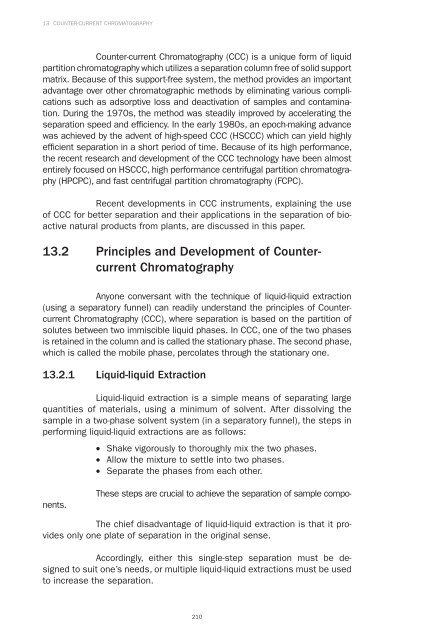Extraction Technologies for Medicinal and Aromatic ... - Capacity4Dev
Extraction Technologies for Medicinal and Aromatic ... - Capacity4Dev
Extraction Technologies for Medicinal and Aromatic ... - Capacity4Dev
You also want an ePaper? Increase the reach of your titles
YUMPU automatically turns print PDFs into web optimized ePapers that Google loves.
13 COUNTER-CURRENT CHROMATOGRAPHY<br />
Counter-current Chromatography (CCC) is a unique <strong>for</strong>m of liquid<br />
partition chromatography which utilizes a separation column free of solid support<br />
matrix. Because of this support-free system, the method provides an important<br />
advantage over other chromatographic methods by eliminating various complications<br />
such as adsorptive loss <strong>and</strong> deactivation of samples <strong>and</strong> contamination.<br />
During the 1970s, the method was steadily improved by accelerating the<br />
separation speed <strong>and</strong> efficiency. In the early 1980s, an epoch-making advance<br />
was achieved by the advent of high-speed CCC (HSCCC) which can yield highly<br />
efficient separation in a short period of time. Because of its high per<strong>for</strong>mance,<br />
the recent research <strong>and</strong> development of the CCC technology have been almost<br />
entirely focused on HSCCC, high per<strong>for</strong>mance centrifugal partition chromatography<br />
(HPCPC), <strong>and</strong> fast centrifugal partition chromatography (FCPC).<br />
Recent developments in CCC instruments, explaining the use<br />
of CCC <strong>for</strong> better separation <strong>and</strong> their applications in the separation of bioactive<br />
natural products from plants, are discussed in this paper.<br />
13.2 Principles <strong>and</strong> Development of Countercurrent<br />
Chromatography<br />
Anyone conversant with the technique of liquid-liquid extraction<br />
(using a separatory funnel) can readily underst<strong>and</strong> the principles of Countercurrent<br />
Chromatography (CCC), where separation is based on the partition of<br />
solutes between two immiscible liquid phases. In CCC, one of the two phases<br />
is retained in the column <strong>and</strong> is called the stationary phase. The second phase,<br />
which is called the mobile phase, percolates through the stationary one.<br />
13.2.1 Liquid-liquid <strong>Extraction</strong><br />
Liquid-liquid extraction is a simple means of separating large<br />
quantities of materials, using a minimum of solvent. After dissolving the<br />
sample in a two-phase solvent system (in a separatory funnel), the steps in<br />
per<strong>for</strong>ming liquid-liquid extractions are as follows:<br />
• Shake vigorously to thoroughly mix the two phases.<br />
• Allow the mixture to settle into two phases.<br />
• Separate the phases from each other.<br />
These steps are crucial to achieve the separation of sample components.<br />
The chief disadvantage of liquid-liquid extraction is that it provides<br />
only one plate of separation in the original sense.<br />
Accordingly, either this single-step separation must be designed<br />
to suit one’s needs, or multiple liquid-liquid extractions must be used<br />
to increase the separation.<br />
210

















